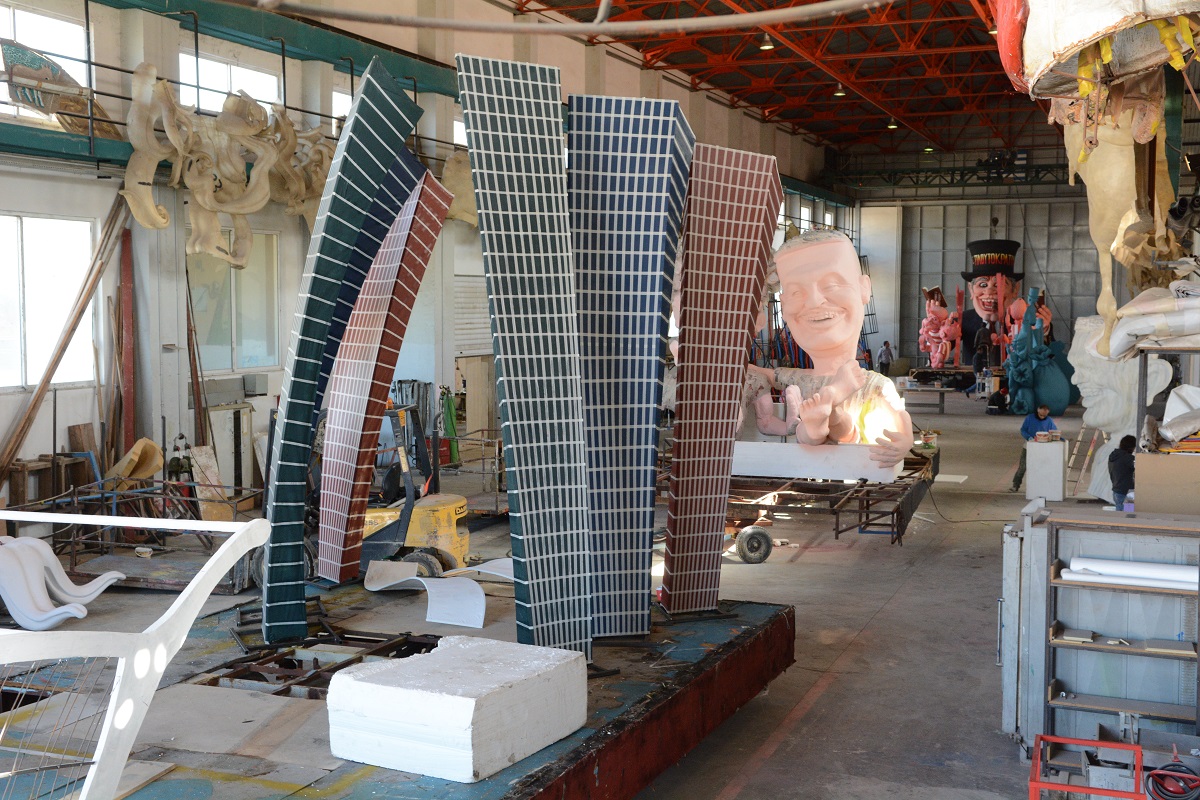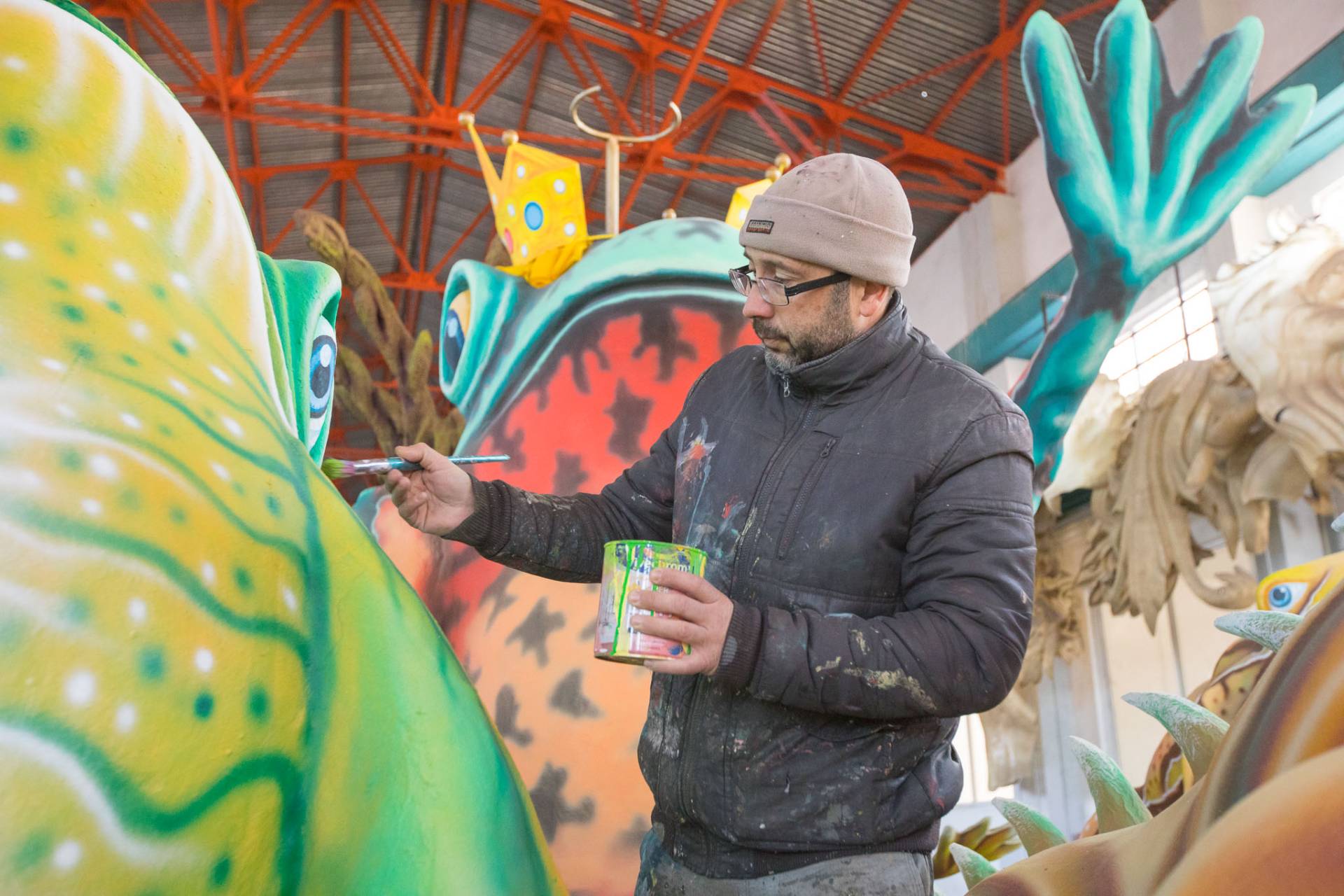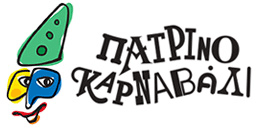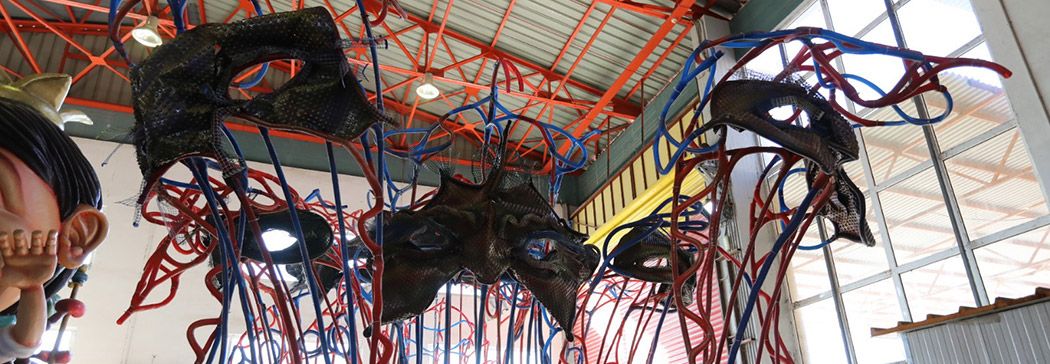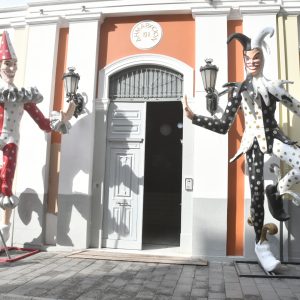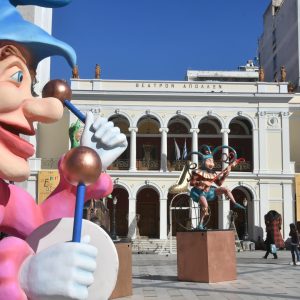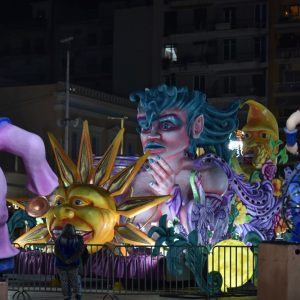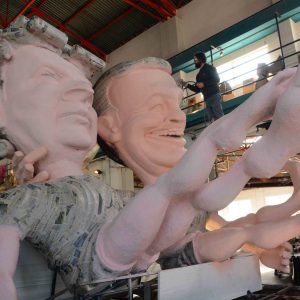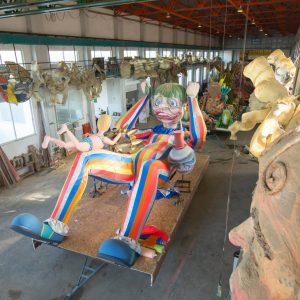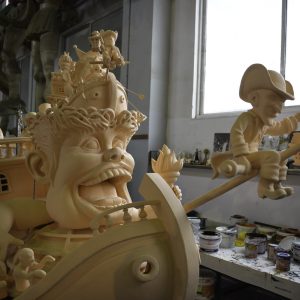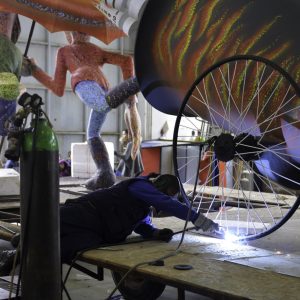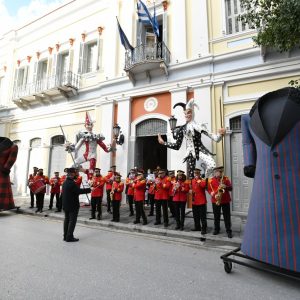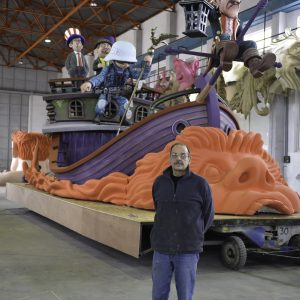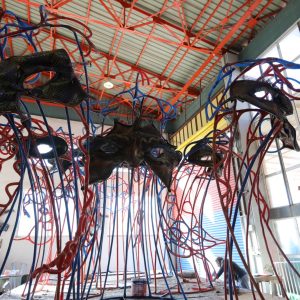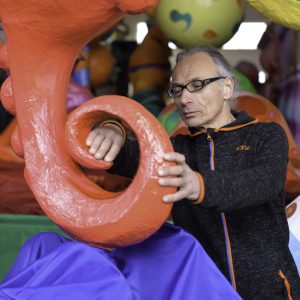The floats of the Patras Carnival, which are built every year by the Carnival Workshop of the Municipality of Patras, constitute an inextricably linked feature with the great celebration of Patras, which gives it its identity and personality, with which it has been established in the consciousness of the whole country as the leader in its kind in a panhellenic scale and as one of the most important internationally.
The carnival floats of the Municipality of Patras are the trademark of Patras Carnival and its most authentic parameter, indissolubly connected to its tradition and history.
Indicators of carnival fun, skyrocketing the cheerfulness, leaving excellent impressions and standing out during the big Carnival parades.
Excellent and elaborate creations signed by the artists of the Carnival Workshop, the Carnival King figure, the Queen’s float and the floats of their accompaniment are sculpted with equipment such as the rare inspiration, the imagination, the ingenuity and the high craftsmanship.
The carnival floats of the Municipality transpire a satirical spirit, they are sealed by the high-quality level and the perfect technique of their creators and they combine the timelessness of the carnival spirit with the timeliness of the subjects, which are often drawn from the political and social circumstances of the times.
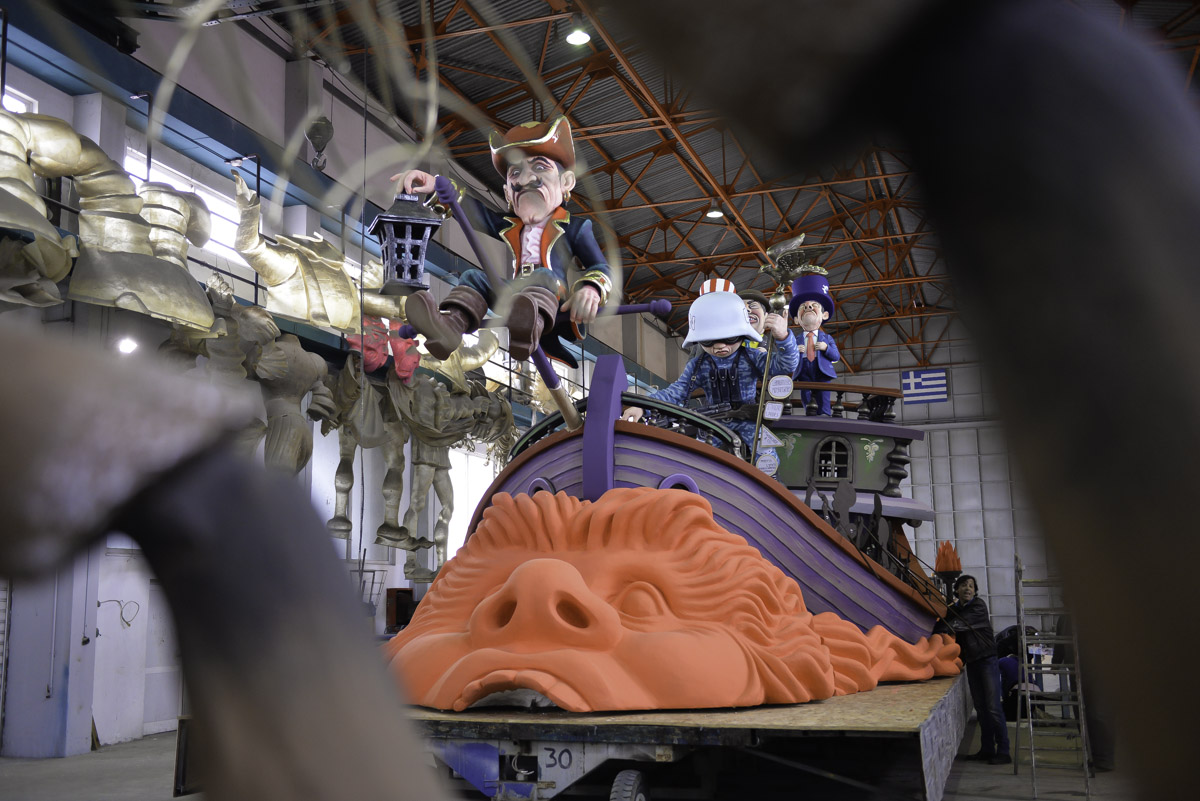
The history of the floats and the structures is long-standing.
The 1870s are characterized by the appearance of the first carnival floats, which were built with private funding. They mainly satirized the social and political situation, with the floats of the Carnival King, the Queen of the Patras Carnival and, later, the flower floats being the dominant ones. 1952 is a pivotal year for the development of Patras Carnival since the responsibility and the organization of it was undertaken by the Municipality of Patras, which will later also be in charge of the creation of the carnival floats. The Municipality of Patras initially granted the constructors the site of the old gas factory (Gazi) in the “Krya” location, in the old buildings of Akti Dymaion street,where in recent years the services of the Municipal Water Supply and Sewerage Company of Patras have been housed, for the creation of carnival floats. According to the procedure, the contractors submitted to the municipality a plan, the creation costs the builders’ fees, and the relevant municipality committee responsible for the carnival competitions approved the final chariots according to mainly artistic criteria.
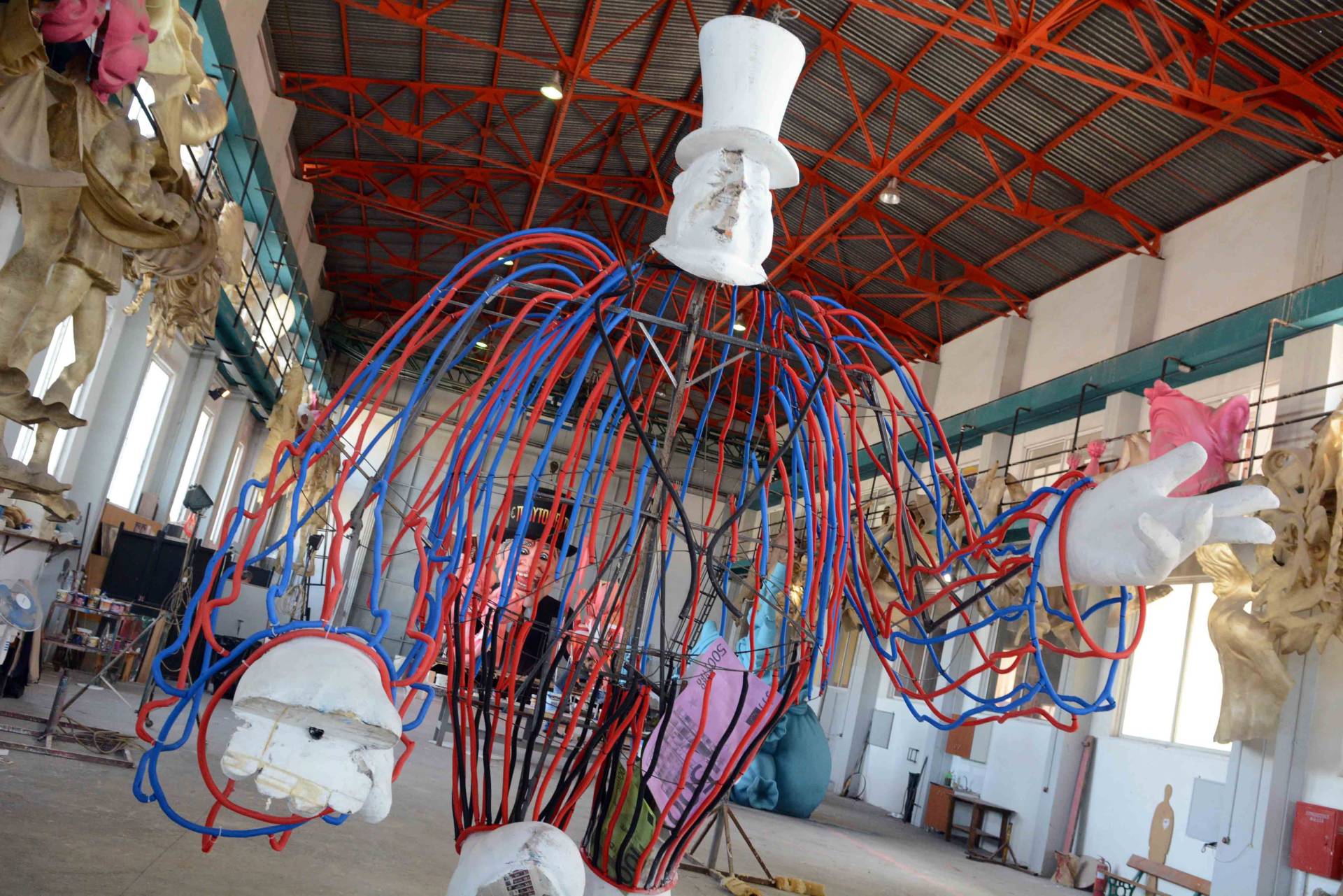
In 1959 in a fire caused in the depot of tanks in Gazi, causeddamages to the Carnival King’s float and two other floats. The arsonists were not discovered, but the public opinion was left with the impression that the fire was an act of militant fanatical Christian anti-carnivalists who were hostile to everything carnivalesque, considering it pagan and anti-Christian. After all, in that period, from 1952, there was intense anti-carnival activity.

In the field of constructing carnival floats, excelled the well-known painter, iconographer and sculptor Nikolaos Atzaritis, Nikos Kokorogiannis, the visual artist and painter Grigoris Papatheodorou, Alekos Hararis, who was also the creator of the excellent “mascaratas” – sizeable carnival constructions that can be worn, Tim. Andrikopoulos, G. Kapes, D. Koutsis, but also important Athenian stage designers, such as Panagiotis Stefanidis, Simis, Kentakis, Kapuralis and Philippoussis, while the creation of the flower floats, that had timidly made their appearance since the 1920s, was later connected to the florists Nikolaos Maroudas (in 1952 he created the first post-war flower float: a pagoda, in the center of which, a geisha conjured a snake while playing a mandolin), Andreas Maroudas (from his most beautiful chariots was a huge clam which was dragged by four dolphins, all made of flowers and in the center of the clam sat the queen of Carnival), and Andreas Evaggelatos. An inexhaustible source of inspiration for the subject matter of carnival floats were the themes of mythology, history, but also the modern social and political situation that was treated with humor and satirical mood by the creators-manufacturers, while the artistic floats were also present.
Carnival floats are created within the Carnival Workshop (which was also called the Carnival Garage). From there they became available, and still become available, to be displayed to the spectators and become an object of admiration and curiosity, and to cause merriment and laughter during parades, and there they return, closing their few-day ephemeral course of glory either to be recycled or to be repurposed with other uses and “faces” for future carnivals.
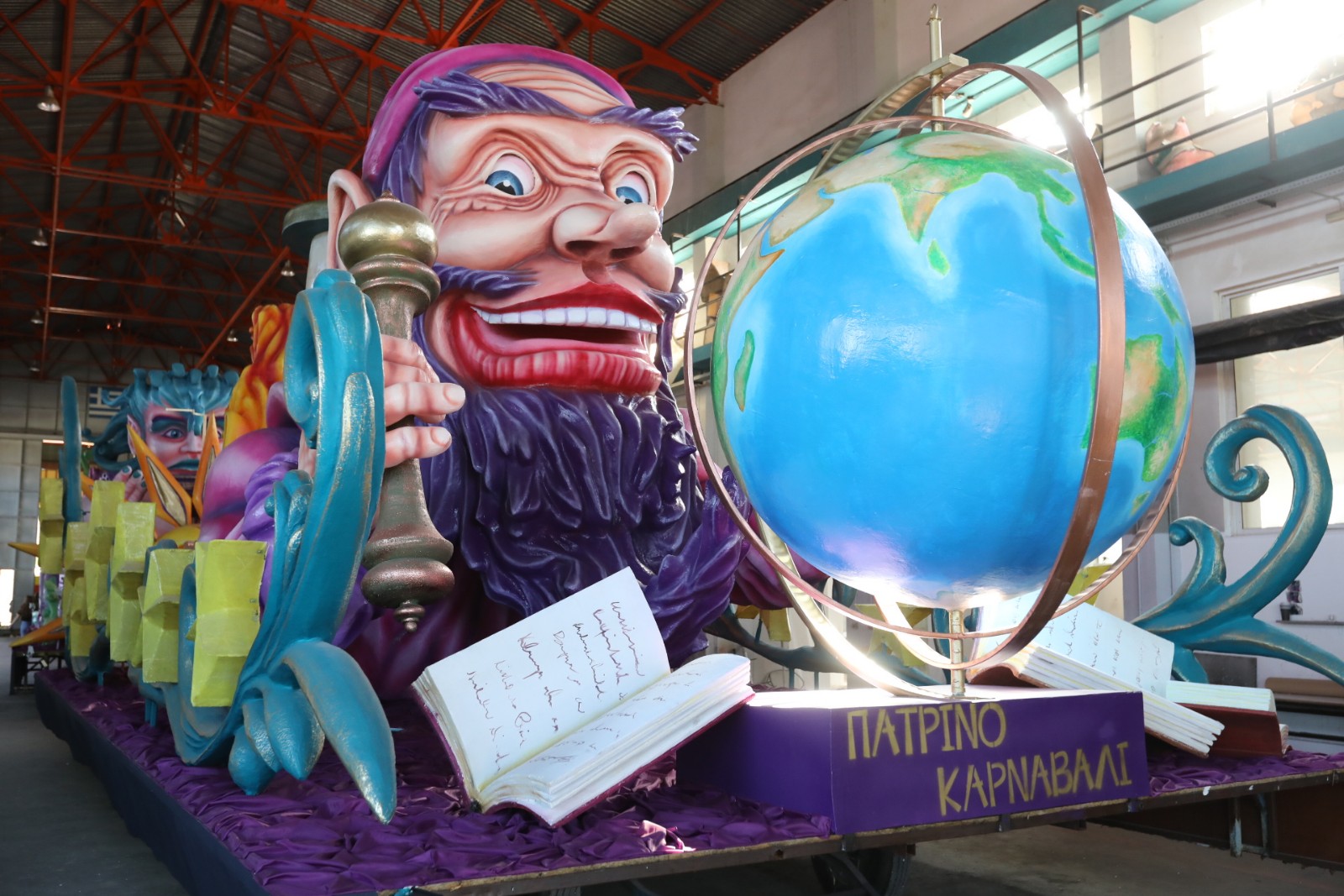
As the “king” of laughter, the Carnival King sits on a throne, usually wears a crown and colorful, “luxurious” attire and holds a scepter. Huge in size, domineering,he has “carmine cheeks and a runny nose from drinking too much wine”.In 1953 the predominant float of the parade, that of the Carnival King, becomes animated and “comes alive” thrilling the spectators. His head spins, his eyes blink, his hands move, greeting the crowd of spectators. Over time the chariots increase in number but also, in spectacle, in every event. In 1955 he sits on a rooster and in 1956 on a barrel. In 1959 the Carnival King was lying on arecliner, while in 1960 on an impressive and imposing construction (height: 6m and length, including the towing vehicle: 12m), he came with a gondola towed by two sea serpents led by the reins of a mermaid.
In 1964 Grigoris Papatheodorou created a special Carnival King that could get up from his throne with the help of mechanisms and sit down again, expanding, with originality and technical innovation, the construction of the floats and igniting the interest. Dimitris Vourtsis, a student of Papatheodorou, who created for the Carnival from 1964 to 1988,made his first Carnival King in 1978. He was associated with top-tier constructions and impressive Carnival Kings of Patras Carnival such as the oversized “Bokasa” Carnival Kingwith the elephants, that, in 1978, satirized the cannibalistic ruler-dictator of Central Africa. Due to this float, a diplomatic episode was almost caused,after the acute dissatisfaction of the Central African Embassy, which was avoided by conversions in the final implementation. Carnival King Bokasa turned into a Fakir. In 1979 he created the “Fallen Aristocrat” and in 1986 a Carnival King that opened and closed its mouth,from which sprang carnivalesque figures. In 1987 he created the “Centaurs” Carnival King and then he retired. Following his own proposal to the Municipality of Patras, the Carnival Workshop of the Municipality of Patras was created in 1988, which was housed in the area of the former Ladopoulos paper industry, offering better conditions of work in relation to the terrible conditions and the high humidity that prevailed in the old gas factory (Gazi).In Gazi, in 1988, Dimitris (Tzimis) Souliotis, also a student of Papatheodorou and in charge of several floats for the Carnival (period of action:1960-1994), built the last Carnival King that was created there. His wife, Areti Souliotis, was also the chief constructor, mainly responsible for the paper-coating of the floats. Other important float makers were Seferiadis and Papalexatos.
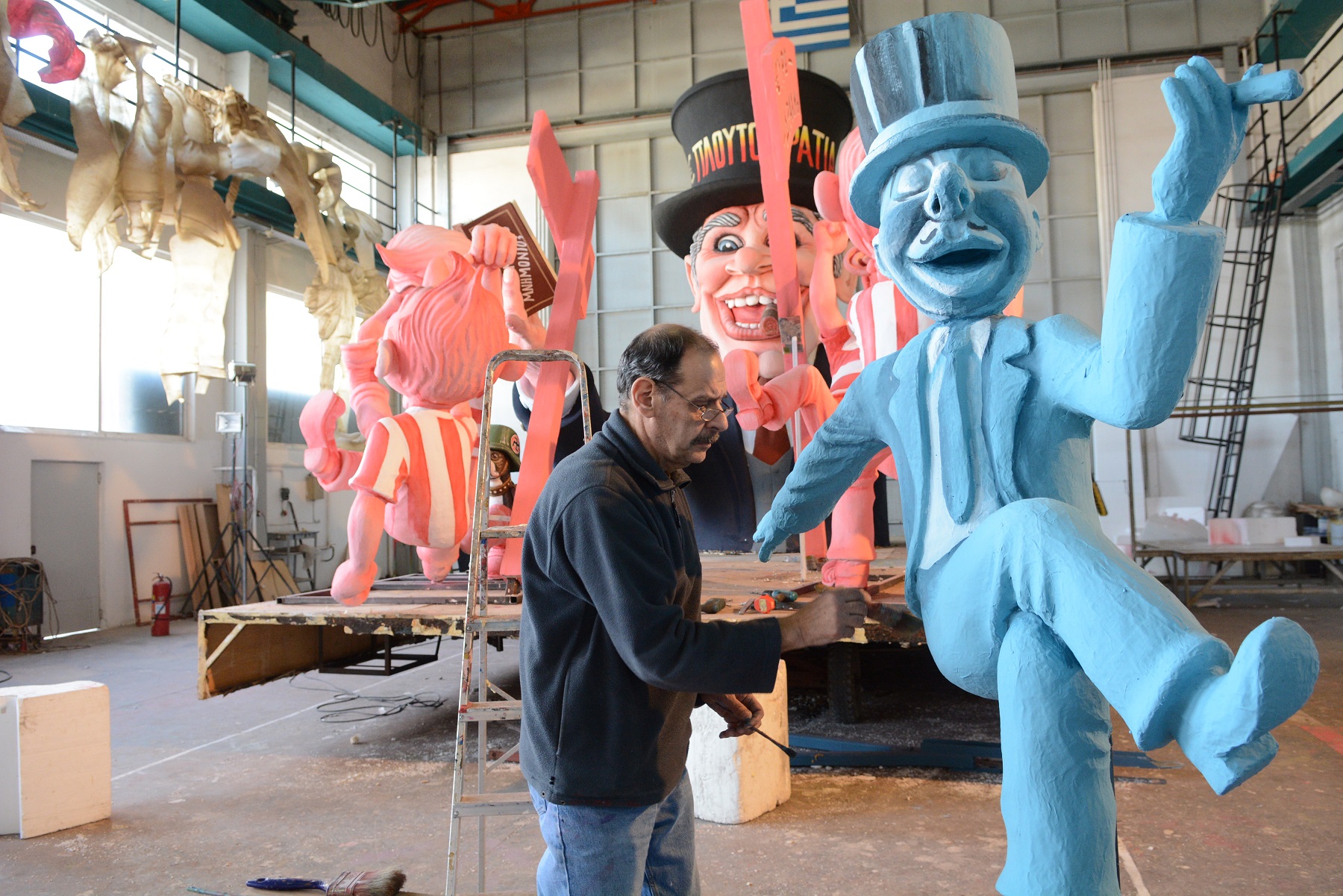
From 1988 to 1993 the artistic director of the workshop was the artist TasosTsailakis who left his own creative imprint on creations, while from 1994 until 2019, Petros Vryonis took over the artistic responsibility and direction of the laboratory, an epoch-making event,and hecreated extraordinary Carnival Kings and important floats that were loved on a panhellenic scale, with his rare criterion,his artistic vein and his inventive spirit. Petros Vryonis was associated with great artistic and satirical constructions of floats that left a strong imprint on the modern era of the Patras Carnival. Some of his Carnival Kings were “Carnival Odysseus” (1998), “Lion of Nemea” from the labors of Hercules (2000), “Zeus and his transformations” in a Carnival dedicated to the Abduction of Europa (2001), the two athletes, Carnival Kings of 2004, “The Wizard of the Internet” (2008), the Oriental Carnival King of 2015, etc. His last floats for the Patras Carnival were magnificent Carnival Kings with subject-matter inspired by the financial crisis in the years 2016 (plutocrat with semi-high, cigar and the books of memorandum), 2017 (seafaring plutocrat boarding the ship of inequality, and where one crisis begets the next and so on), and 2019 (the satire of bourgeois democracy).
It is worth underlining the post-war creation of“mascaratas” – sizeable carnival constructions that can be worn, by AlekosHararis, which imparted a note of cheerfulness (comical and satirical spirit) but also distinct atmosphere at the parade. Hararis created during the period when the constructions were taking place in Gazi and, with the poor means at his disposal, he transformed the humble and ephemeral materials in portable pedestrian figures and elements that, with a distinct movement, used to come close to the people during the parade, flanking the floats and the various musical groups. Often the masquerades (5-6 elements with a common satirical theme) were foundahead of the Carnival King, effectively heralding its arrival at the parade.
In 1988, the year of creation of the Carnival Workshop of the Municipality of Patras, an important project was implemented, for the training of creators of the distinctive technique of carnival floats and constructions. The School of Carnival Float Makers was founded by the Municipality of Patrasand OAED, with the aim of preparing skilled craftspeople who would later work at the Carnival Workshop. Petros Vryonis and Tzimis Souliotis were teaching at school.
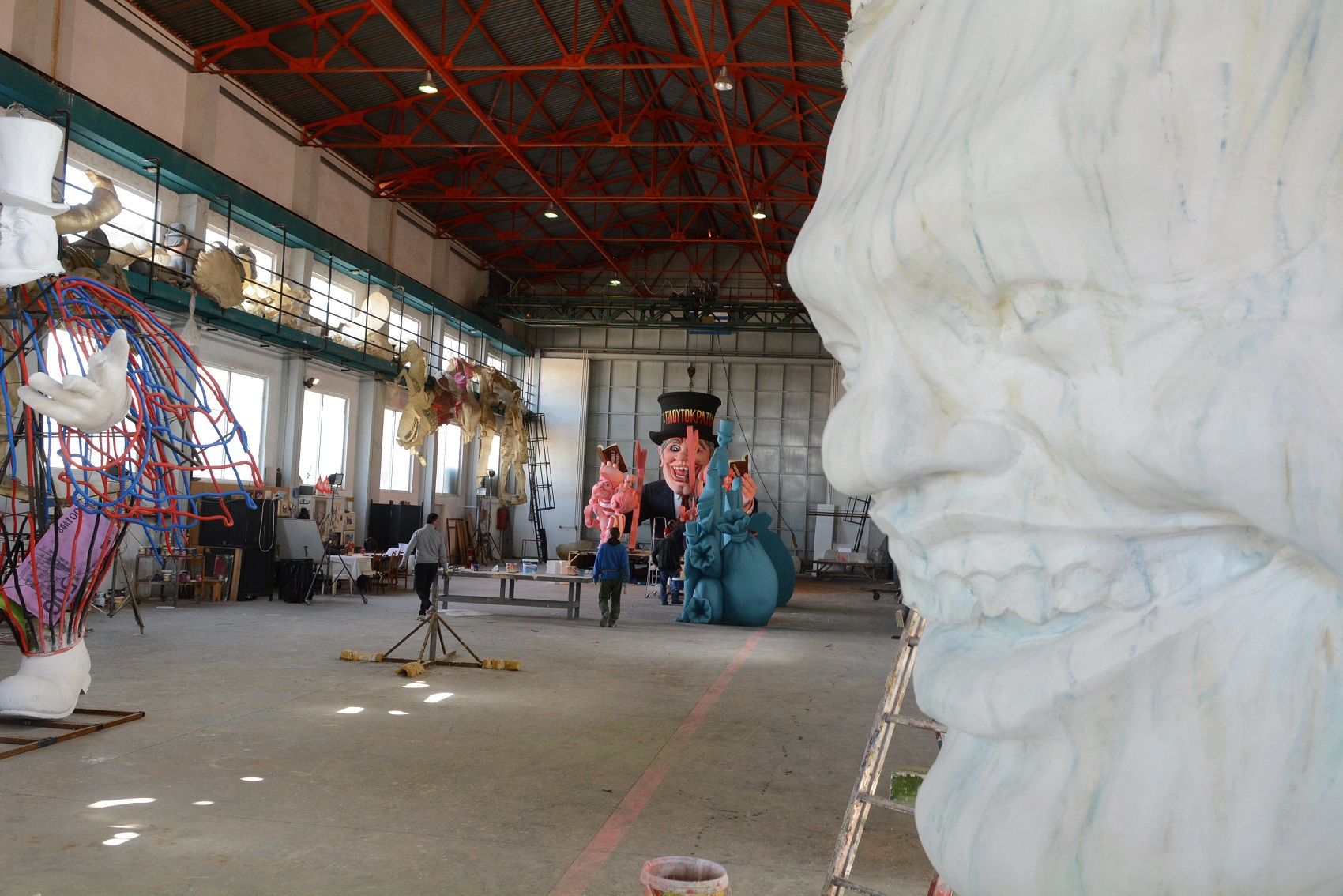
In 1995, the Carnival Workshop was transferred to Petroto, in a huge space-building, ideal for the constructions, autonomous, with unlimited outdoor spaces, where the heart of Patras Carnival still works and beats to this day.There, is sculpted the Carnival King’s float and its impressive entourage’s, the Queen’s, and all floats and carnival constructions, there are produced the carnival dreams that skyrocket the great festival of Patras. The floats of the Children’s Carnival are made there, that march in the Children’s Parade but also in the big parades of the last two days of the Carnival (Pantelis Hatzopoulos created several toy floats for the children where they could play and have interactive participation with them), elements and constructions of the carnival decoration of the city, bastakes that give impressive colour as oversized carnival constructions in the streets and squares of the city, the carnival souvenirs and items available from the Trion Simmahon square’s carnival kiosk,and everything else that the inspiration and imagination of the artists-creators of the Carnival Workshop can conceive. Creation is not limited to carnival subjects, since at the Carnival Workshop, which is a workshopof all kinds of creation, elements of the Christmas decoration of the city are made, elements for theatrical performances, etc.
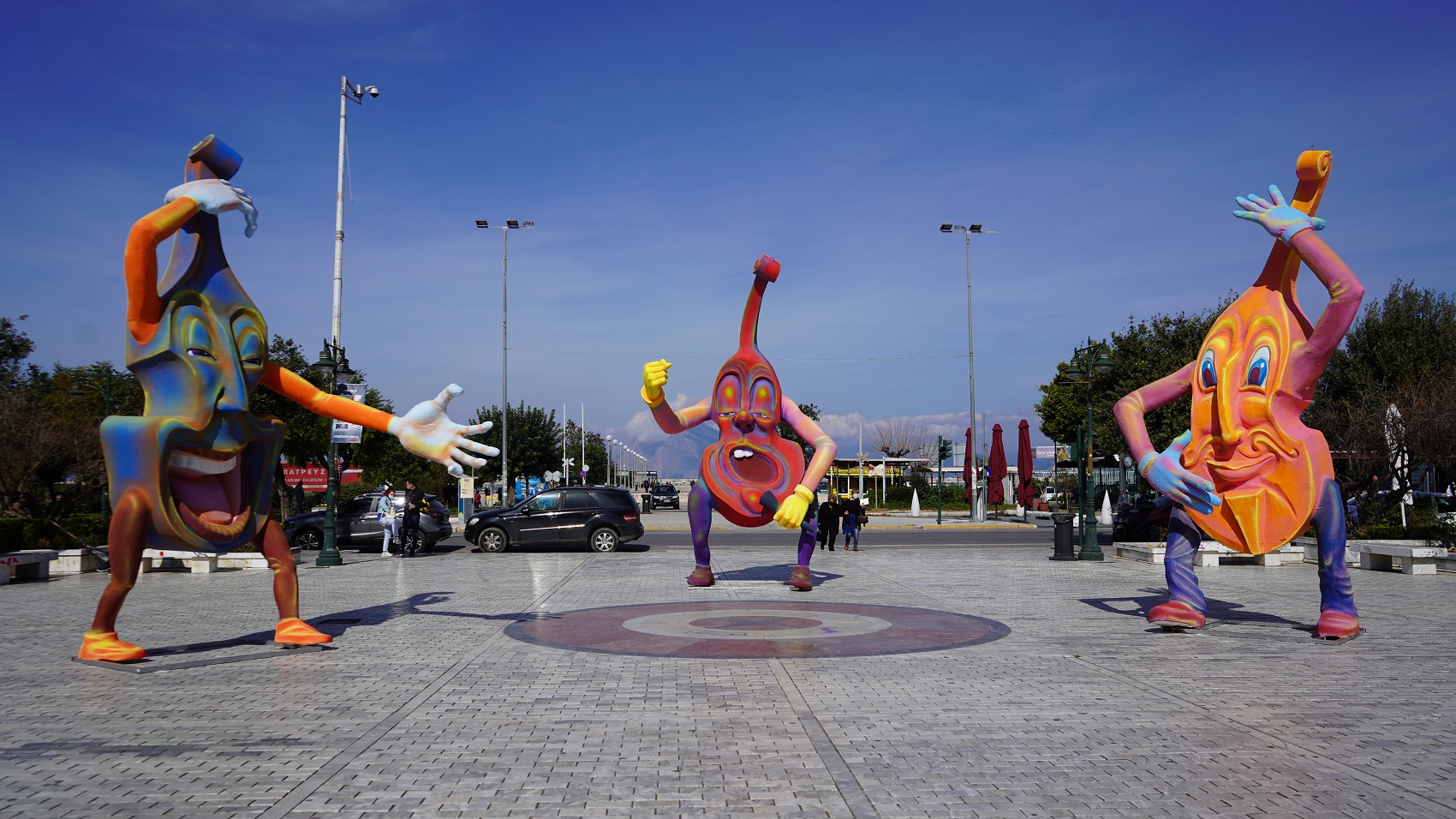
The Carnival Workshop of the Municipality of Patras has the ability to produce carnival elements for sale or rent and for this purpose it cooperates with other Municipalities, agencies and individuals whom it supplies according to their needs, by creating something for a special request, or from the list of carnival elements available.
At the same time, the Carnival Workshop often welcomes, regardlessof the carnival season, schools, from all over Greece, and organized groups, and guided tours of its history and the special construction technique of the carnival floats are carried out by its specialized artists and craftsmen.
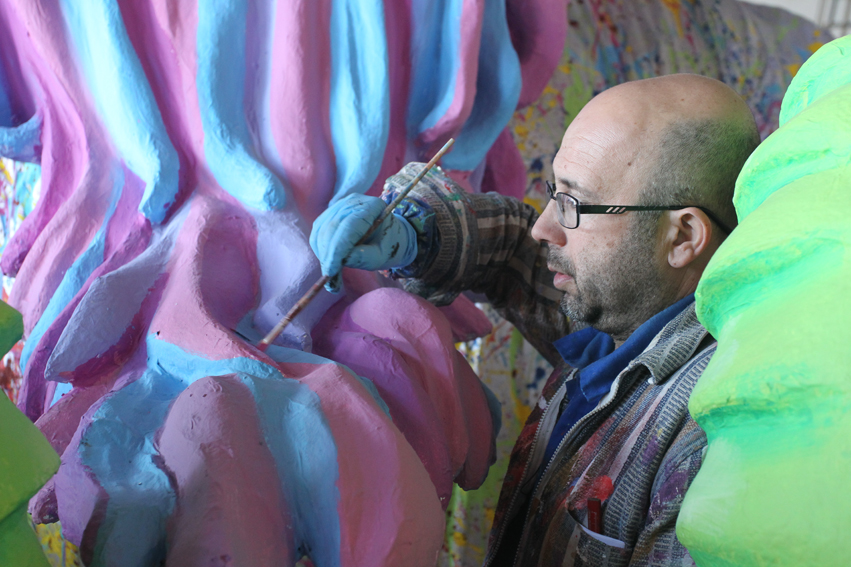
Today, the creator-constructor in charge of the Carnival Workshop is Nikos Livanis (creator of Carnival King, Carnival Queen, floats of the Kids Carnival, while some years ago he created a flower float, by bringing back after years the float that delighted the people in the old Carnivals), who together with Dimitris Ntzoumanis, Nektarios Sarigiannis, who combine the proven techniques with experimentation with new materials and techniques, and with other artists and craftsmen, they are inspired and implement the “carnival arsenal” and whatever means the city needs for its outgoing image to locals and visitors. Creators with great artistic vein, satirical spirit, long experience, and with special knowledge of carnival style that hold the future of the Patras Carnival.
The Carnival Workshop belongs to the Directorate of Architectural Design of the Municipality of Patras
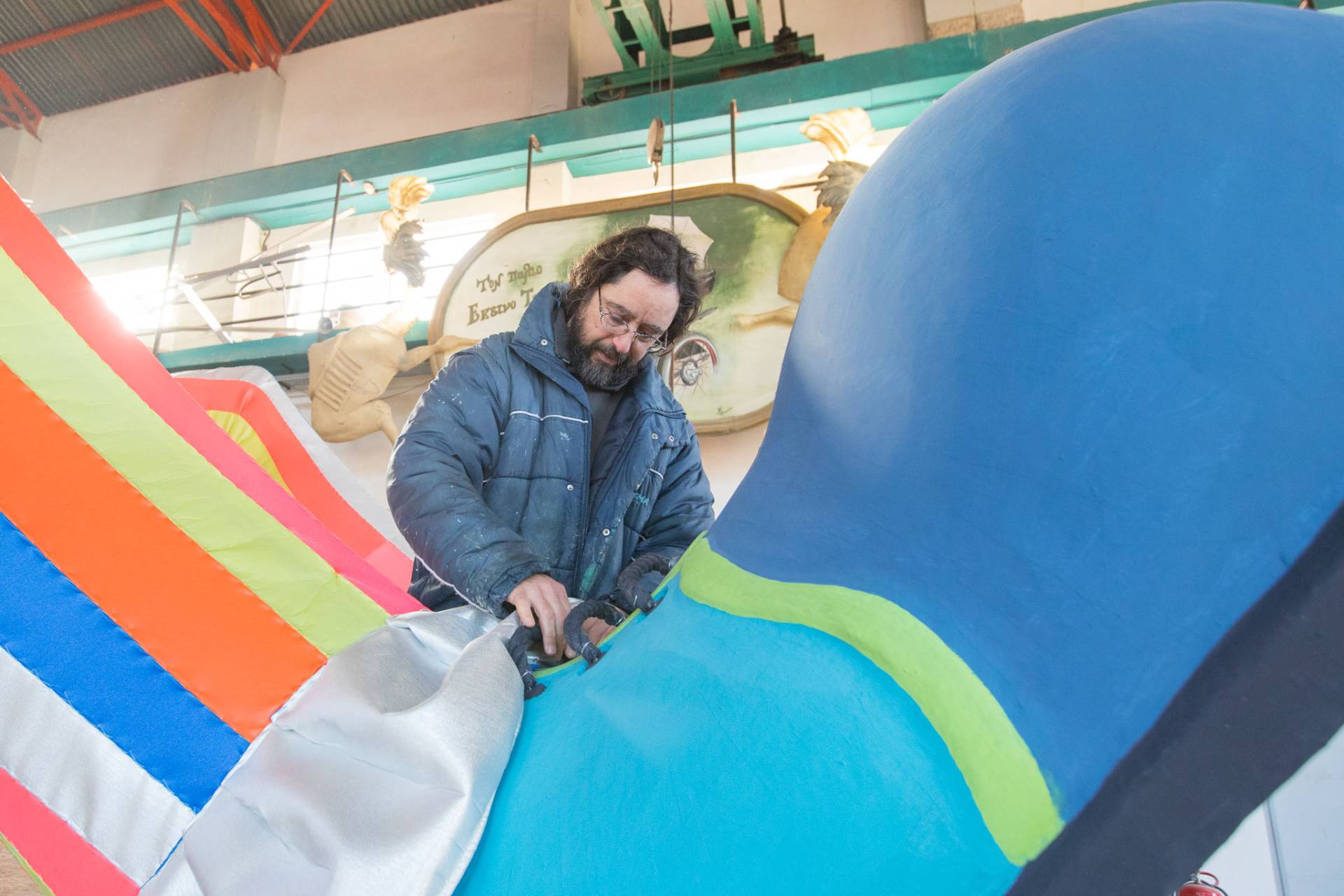
The manufacturing technique
Since 1968, after some experimentation by Dimitris Vourtsis, the use of styrofoam for the construction of the floats was established. The material may have less ecological protection and may be more expensive than wire, clay, plasterand paper which were the previous more cumbersome and unwieldy materials, however, the easy and fast use of it, really facilitated the constructions spectacularly.
Initially, the styrofoam is carvedand, without the need for a mold, it takes the desired shape by the crafts person. To withstand rain, humidity and other conditions, as well as other types of outer pressure, it is subjected to the process of layering with paper, dyeing or using polyester on it. After the paper-layering the styrofoam gives the most ideal and finished result. Hairpins are used to join the different sections. At first the styrofoam is cut and glued with polyurethane to the iron frame. The carving follows, with special tools, and then the paper layering, and then the plastic paint with which the material is covered, and then the varnishing that makes it harder and durable.
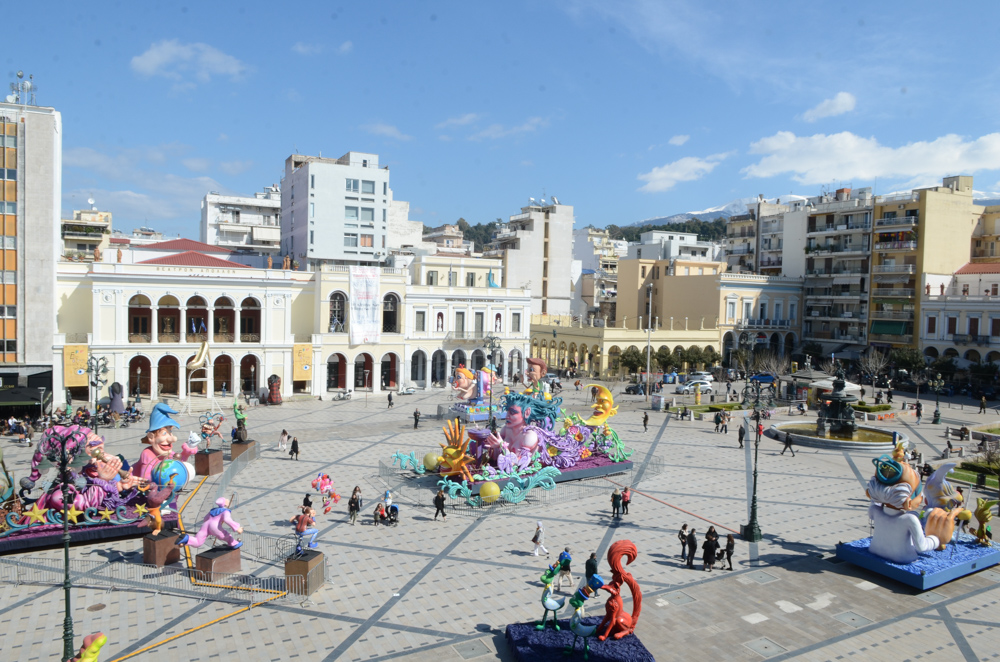
The movement of the floats is a basic requirement and is achieved by the mechanisms which are done hydraulically or manually.
Nevertheless, mainly in the satirical floats, that give greater frameworks of freedom for their construction, other materials are now being used, that were used formerly, and now they acquired another form. Such materials were wire, a malleable material that was combined with styrofoam through mixed media, wire, latex.
*Information taken from the sources:
– Nikos E. Politis “The Carnival of Patras” (published by Pikramenos, Patras 2015, first edition: Achaikes Editions, Patras 1987).
– Xenophon Arg. Papaeuthymiou “Alekos Hararis (1918-1979): A folk artist of maskaratas” (published by the tooth, Patras 2011)
– KEDHP archive – Patras Carnival
